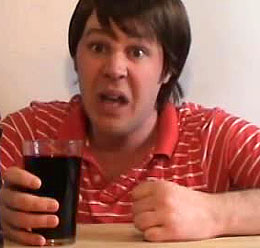 I made my first 5 gallons of plum wine last fall and it turned out really well. Recently I decided to try making grape wine using frozen grape concentrate. I figured on only doing a gallon to start with before making a larger batch. I used a plastic gallon milk jug for the primary fermentation and after the second day decided to stir the wine. That turned out to be a huge mistake! As soon as I started to stir, there was a violent reaction and grape juice shot about 5 feet up the wall and made a big mess. Before it settled down I lost about a quart of the product and now I am not sure what to do. Can I just go ahead and top it off with water or do I need to start over? Also, what caused the violent reaction in the first place? Thanks for any advice you can provide.
I made my first 5 gallons of plum wine last fall and it turned out really well. Recently I decided to try making grape wine using frozen grape concentrate. I figured on only doing a gallon to start with before making a larger batch. I used a plastic gallon milk jug for the primary fermentation and after the second day decided to stir the wine. That turned out to be a huge mistake! As soon as I started to stir, there was a violent reaction and grape juice shot about 5 feet up the wall and made a big mess. Before it settled down I lost about a quart of the product and now I am not sure what to do. Can I just go ahead and top it off with water or do I need to start over? Also, what caused the violent reaction in the first place? Thanks for any advice you can provide.
Name: Larry C.
State: Idaho
—–
Hello Larry,
Your best option at this point is to do nothing. You could try to make up for your loss of wine, but you would need to do it at the same ratio of the original wine recipe you are using… not too practical.
Your best bet is to let the fermentation finish. After that you need to find a container that matches the size of the your remaining batch to keep it in while it’s clearing. You want to eliminate head-space in the container while the wine is clearing and waiting to go into wine bottles.
The reason stirring your wine resulted in an eruption of sorts was something called nucleation. Nucleation is the same exact principal that causes a 2 liter bottle of soda pop to spew when a Mentos candy is drop into it. A Mentos has millions of pores on its surface that cause the CO2 molecules in the soda pop to come together and form gas bubbles.
During a fermentation the yeast produces CO2 gas (carbon dioxide) along with the alcohol. This is what you see coming through the air-lock. But in addition to what goes through the air-lock is much more still saturated in the wine. The wine holds as much as it can until it is disturbed, much like carbonated soda pop.
Stirring the wine started a chain reaction of liquid CO2 expanding and releasing from the wine as a gas. The CO2 expands rapidly causing the wine to gush or spew.
What you used to stir the wine makes a difference as to how fast or violent the CO2 gas will erupt. The more porous the surface of the stirring device, the faster the eruption will occur. As an example, if you are stirring the wine with a glass spoon, you would get little to no reaction because of its smooth surface; if you are stirring the wine with a wooden spoon you would get a significantly larger reaction because of its porousness. The surface of a Mentos is so porous that all you have to do is drop it into the wine/soda pop to get the reaction you experienced.
In addition, the inner walls of the milk jug was probably working in concert with the stirring motion to cause this to occur. At least, that is my suspicion. The plastic used to produce milk jugs is porous, as well. Sloshing the wine against the inner walls of the jugs would help to cause the CO2 gas to release. In fact, it may have not even mattered what you stirred with. It could have been the inner walls of the jug that did it all. All it took was stirring the wine in any fashion to ignite the eruption.
Happy Winemaking,
Ed Kraus
———————————————————————————————————
Ed Kraus is a 3rd generation home brewer/winemaker and has been an owner of E. C. Kraus since 1999. He has been helping individuals make better wine and beer for over 25 years.

If I’m using juice to make my wine, can I add fruit after the primary fermentation? Also if I don’t use a bag for my fruit what is the best way to get the wine out my bucket without fruit particles going into my next racking and how long should I let it sit, from primarily fermentation, to secondary fermentation to racking etc?
Do you always have to wait until a wine clears to drink it? Mine taste good and the abv is 15% just how I like it but it’s not clear. It’s a juice wine that’s been sitting 30 days.